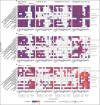This is a preprint.
Disease stage-specific atrophy markers in Alzheimer's disease
- PMID: 40162264
- PMCID: PMC11952614
- DOI: 10.1101/2025.03.13.25323904
Disease stage-specific atrophy markers in Alzheimer's disease
Update in
-
Disease stage-specific atrophy markers in Alzheimer's disease.Alzheimers Dement. 2025 Jul;21(7):e70482. doi: 10.1002/alz.70482. Alzheimers Dement. 2025. PMID: 40691867 Free PMC article.
Abstract
Introduction: Structural MRI often lacks diagnostic, prognostic, and monitoring value in Alzheimer's disease (AD), particularly in early disease stages. To improve its utility, we aimed to identify optimal MRI readouts for different use cases.
Methods: We included 363 older adults; healthy controls (HC) who were negative or positive for amyloidbeta (Aβ) and Aβ-positive patients with subjective cognitive decline (SCD), mild cognitive impairment, or dementia of the Alzheimer type. MRI and neuropsychological assessments were administered annually for up to three years.
Results: Accelerated atrophy of distinct MTL subregions was evident already during preclinical AD. Symptomatic disease stages most notably differed in their hippocampal and parietal atrophy signatures. Associations of atrophy markers and cognitive inventories varied by intended use and disease stage.
Discussion: With the appropriate readout, MRI can detect abnormal atrophy already during preclinical AD. To optimize performance, MRI readouts should be tailored to the targeted disease stage and intended use.
Conflict of interest statement
J.W. has been an honorary speaker for Beeijing Yibai Science and Technology Ltd, Eisai, Gloryren, Janssen, Pfizer, Med Update GmbH, Roche, Lilly, Roche Pharma, and has been a member of the advisory boards of Abbott, Biogen, Boehringer Ingelheim, Lilly, Immungenetics, MSD Sharp-Dohme, Noselab, Roboscreen, Roche Pharma and receives fees as a consultant for Immungenetics, Noselab, and Roboscreen. J.W. holds the following patents: PCT/EP 2011 001724 and PCT/EP 2015 052945. All other authors report no conflicts of interest relevant to this work.
Figures



References
Publication types
Grants and funding
LinkOut - more resources
Full Text Sources
